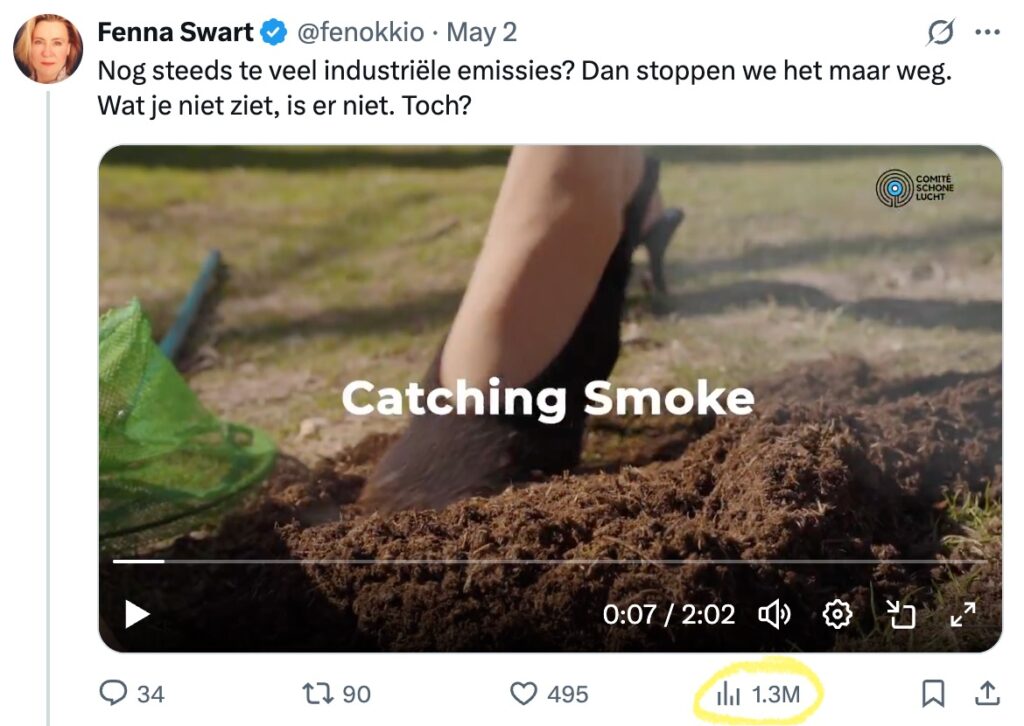Premiere ‘Catching Smoke’ (The Movie) shows absurdity of BECCS in Dutch Climate plans
The Dutch Climate Minister Sophie Hermans wants to focus heavily on so-called ‘CO2 capture and storage’ at biomass power stations. This under the motto of ‘sustainable CO2 removal’. The cabinet has opened new incentive subsidies (SDE) for this purpose. The share of woody biomass combustion in the renewable energy mix was already 35-40 percent in 2023. Sun and wind are mentioned, biomass is often conveniently omitted. Wrongly, it turns out again. In this new, short film ‘Catching Smoke’ (2 min) that has been viewed more than 1.4 million times within a week, the Clean Air Committee not only explains why this is an absurd idea, they also discuss the solution. In addition, citizens have their say about the climate plans of this cabinet.
In big steps quickly home
Climate Minister Hermans indicates in the Climate Plan 2025-2035 and the Roadmap CO2 removal that he wants to speed up with BECCS, biomass combustion with CO2 capture and storage. The minister sees BECCS as a form of CO2 removal. This while international science such as IPCC and EASAC has made it clear that BECCS is counterproductive; it does not remove CO2 and is destructive to forests and biodiversity. Citizens pay for this with tax money. The film ‘Catching Smoke’ has gone viral via social media. In the coming month, BECCS will be prominently on the agenda during three debates in the House of Representatives.
The climate plan shows a deep divide between climatologists (IPCC) on the one hand, and ecologists and nature conservation organizations on the other. But how valid is a Climate Plan that has been designed by climate, energy and business experts but where the ecological perspective is missing?—Fenna Swart, Director Clean Air Committee
Background
Increased carbon concentration and warming
The IPCC has made it clear that we must immediately and drastically reduce carbon emissions to prevent the worst consequences of climate change. The use of biomass power plants with BECCS on a global scale will have the opposite effect. A letter signed by nearly 800 scientists, including recipients of the U.S. National Medal of Science and lead authors of multiple IPCC reports, explains that “the use of intentionally harvested wood for combustion will increase atmospheric carbon concentrations and warming for decades to centuries.” Burning biomass for electricity emits about 20 percent more carbon than coal and twice as much as natural gas per unit of electricity produced. It also emits (ultra)fine particulate matter and nitrogen.
BECCS does not capture a large portion of CO2 emissions
BECCS cannot capture the vast majority of carbon released during forest clearing (soil oxidation), wood pellet production, and overseas transport before the wood pellets reach a power plant. In addition, capturing and storing CO2 at a power plant requires energy that is also not captured. A report by NRDC (2021) shows that CO2 losses over the entire ‘BECCS chain’ (from deforestation to CO2 storage) are so great that there is no net carbon removal during BECCS. BECCS is therefore counterproductive. A letter from more than 80 scientists also clearly explains that BECCS is not a climate solution.
BECCS disastrous for forests
BECCS requires a great deal of deforestation. Biodiverse forests are replaced by one-sided tree plantations, if replanting takes place at all. Moreover, it will take decades for new trees to store the carbon that is released in a very short time during combustion. If energy company RWE wanted to fuel its two Dutch coal-fired power stations Amer and Eemshaven entirely with woody biomass in the form of BECCS, this would require no less than 7.5 million tonnes of wood annually. Double the import of biomass that is currently allowed to be fired in all Dutch coal-fired power stations. If Dutch forests were used, our forest would be clear-cut in 5 years.

